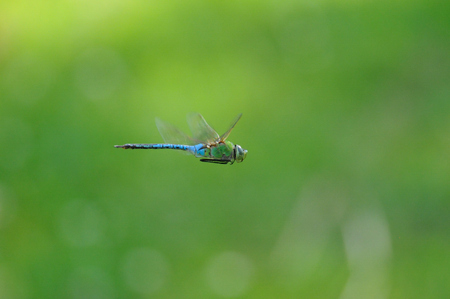
Good Natured: Green Darner
The other day a long-ago memory came drifting back. In it, I was in my Grandma Erickson's backyard, ostensibly helping her hang laundry on the line. At least in my mind, I was helping. I was about 3 at the time, so…you know…
At any rate, the day was sunny and warm, and I was anxious to finish this work of handing Grandma clothespins so we could get on with more important things--like catching bugs.
We were just about finished when, all of a sudden, one of the coolest insects I'd ever seen came darting through the yard. Grandma's opinions, however, were quite the opposite.
“That's a darning needle!" she shouted, and proceeded with a literal laundry list of reasons of why we should run away from, instead of toward, this wondrous new creature. I don't remember all the things she said, but stinging horses and sewing my mouth shut were two of its alleged powers.
Needless to say, I was enthralled. And, I'm happy to say, remain so to this day.
I'm pretty sure that ca. 1965 “darning needle" actually was a green darner--the largest of our area's dragonflies, and one of the largest in North America. Their impressive size and relative abundance make them easy to spot on most any summer day.
Recently, thanks to our abundant rainfall, and the resulting spike in mosquitoes--a favorite food--green darners seem to be everywhere.
Cruising through the air like a fighter pilot on a mission, albeit with wings the length of popsicle sticks, a hungry green darner will pursue skeeters with gusto. Other prey items for this proficient hunter include flies, butterflies, even other dragonflies. In fact, in one much-cited incident, a green darner on the East Coast took down a ruby-throated hummingbird. (But talk about bad timing…for the dragonfly, that is. The attack occurred right in front of a bunch of birdwatchers, who rushed to the aid of the hummingbird and scared the darner away.)
While that story is probably true, many other grandiose tales surrounding darners, and dragonflies in general, are not. Despite everything my, or your, grandmother may have said, they can't sting and they don't bite. Or sew, for that matter.
What they can do, though, is amaze you with their antics in flight. They can fly forwards and backwards, and when chasing after a prey item (or another dragonfly impinging on a territory) they can reach speeds of more than 15 miles per hour.
Even more remarkable, they can keep up these performances for weeks on end. Unlike many adult insects, which do not feed and therefore don't last more than a week or two, an adult green darner can live as long as two or three months.
And while that in itself is impressive, also consider that that same insect spent many months in its immature, or nymph, phase, living in water and breathing thru gills. In this stage the young darner, masters the predatory skills it will retain into adulthood. The only difference is that there are no wings involved and the hunting grounds are underwater.
Green darner nymphs eat their share of mosquito larvae, as well as other aquatic insects. As they grow, they will also take on young crayfish, fish and tadpoles too.
The key to their hunting prowess lies in a secret weapon—a protrusible labium, or lower mouthpart. This jaw-like structure, equipped with two sharp spines, shoots out and nabs whatever hapless prey that comes within range. (Remember the alien in the movie Alien? Remember the body part that would shoot out and grab people? That stunning feature reportedly was inspired by the lower jaw of a baby dragonfly.)
Green darner nymphs hang out in the muck and mud at the bottom of ponds, marshes and slow-moving streams. To find them you'll probably need a net, and maybe a little patience.
But if you'd like to catch a glimpse of an adult green darner, all you have to do is keep your eyes open when you're outside.
As their name suggests, these insects can appear green as they zip past. If you're lucky enough to find one at rest you'll also note that its long, darning needle-like abdomen is either bluish (if it's a male) or brownish (if it's a female).
If you see a bluish one flying in wide circles near a body of water, it's a male protecting its territory. If you see a brownish one sticking its abdomen into the water, it's a female laying eggs. And if you happen to see a bluish one and a brownish one hooked together, well, then, rest assured, more green darners will be coming soon.
Next week: We take a deeper dive into the mating behaviors of dragonflies and their smaller cousins the damselflies.
Pam Otto is the outreach ambassador for the St. Charles Park District and can be reached at potto@stcparks.org.

